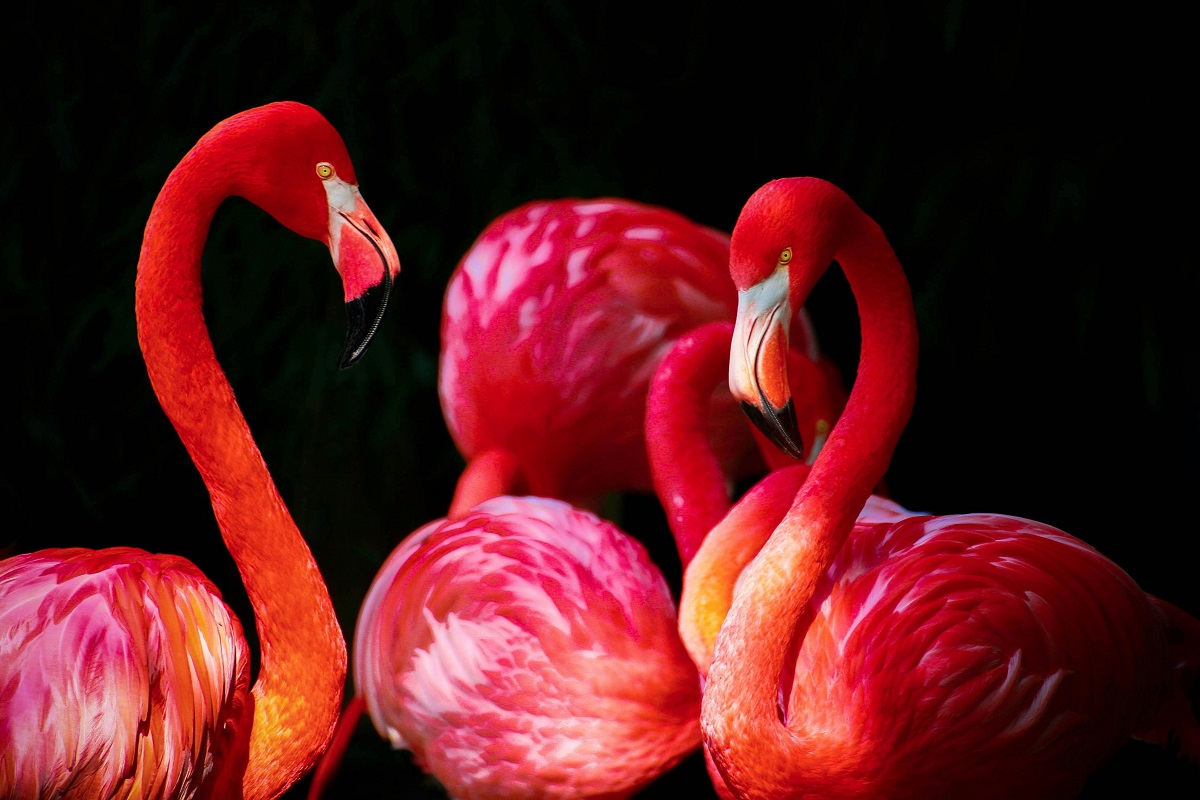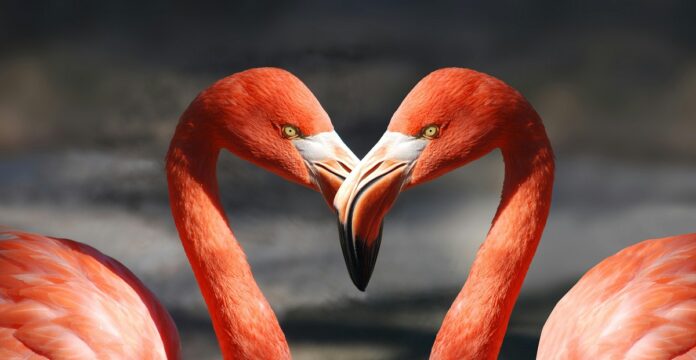Summary: Flamingos are iconic wading birds known for their long legs, curved beaks, and striking pink coloration. They inhabit shallow lakes, lagoons, and wetlands, feeding primarily on algae, shrimp, and small aquatic organisms. Their unique appearance comes from the pigments in their diet, and they are highly social birds that thrive in large colonies. Flamingos are found across Africa, South America, the Caribbean, and parts of Asia, symbolizing grace and balance in nature.
Flamingos are among the most recognizable birds in the animal kingdom. Famous for their elegant posture, long legs, and vibrant pink feathers, these charismatic creatures captivate birdwatchers, photographers, and nature lovers alike. Found across Africa, Asia, the Americas, and parts of Europe, they are beautiful and biologically and behaviorally intriguing. Despite their exotic appearance, they are hardy and adaptive birds that thrive in some of the world’s most extreme environments.
Why Are Flamingos Pink?

One of the most common and intriguing questions about them is why they are pink. Interestingly, they are not born with pink feathers; they hatch with gray or white plumage. Their color comes from carotenoids, natural pigments found in the algae, crustaceans, and small invertebrates that make up their diet. As flamingos digest these foods, the carotenoids are broken down and absorbed, gradually turning their feathers shades of pink, orange, or even red. The richer their diet is in carotenoids, the more vibrant their coloration becomes. In captivity, zookeepers often provide supplements to help maintain their iconic hue.
Species of Flamingos Around the World
There are six recognized species of flamingos, each adapted to different regions and habitats. The Greater Flamingo (Phoenicopterus roseus) is the largest and most widespread species, found in parts of Africa, Europe, and South Asia. The Lesser Flamingo (Phoeniconaias minor), which is smaller but often seen in massive flocks, resides primarily in sub-Saharan Africa and India. In the Americas, the American Flamingo (Phoenicopterus ruber) stands out for its brilliant reddish-pink coloration and thrives in the Caribbean and along the northern coast of South America.
South America is also home to three more species: the Chilean Flamingo, the high-altitude Andean Flamingo, and the James’s Flamingo, the rarest of all. These birds are specially adapted to the salty and alkaline lakes of the Andes, where few other animals can survive. Each species varies in size, color intensity, and bill shape, reflecting their specialized feeding habits and habitats.
Habitat and Distribution
Flamingos typically inhabit shallow lakes, wetlands, estuaries, salt pans, and lagoons. These water-rich environments provide the perfect feeding grounds for filter feeding and offer protection from many land-based predators. One of the most striking features of their habitats is the high salinity or alkalinity, which deters most competitors and predators but suits flamingos perfectly. Iconic flamingo habitats include Lake Nakuru and Lake Natron in East Africa, the Camargue region in southern France, and the salt flats of the Andes in South America.
Diet and Feeding Behavior
Flamingos have an unusual yet highly effective feeding strategy. Their specialized, downward-curved beaks are equipped with comb-like structures called lamellae, which help them filter food from water and mud. By turning their heads upside down and sweeping their beaks side-to-side, flamingos filter tiny food particles from the water. Their diet primarily consists of blue-green algae, diatoms, small crustaceans, and brine shrimp, all of which contribute to their coloration.
In areas where certain food sources are scarce, they may travel long distances in search of better feeding grounds. These migrations are usually dictated by seasonal changes in water levels, food availability, and climate.
Social Behavior and Mating
Flamingos are extremely social birds, often forming large colonies that can range from a few hundred to over a million individuals. Living in such dense groups offers several benefits, including increased protection from predators, synchronized breeding, and more efficient foraging. During the mating season, they engage in elaborate courtship rituals, including synchronized dancing, head-flagging, and vocal calls. These displays not only strengthen pair bonds but also help stimulate breeding activity within the flock.
They typically mate for a single breeding season and form monogamous pairs. They build cone-shaped nests out of mud, where the female lays a single egg. Both parents share incubation duties and later feed the chick with a nutrient-rich secretion known as “crop milk,” which is produced in their upper digestive tracts. The chick is born gray and gradually develops its adult coloration over the next two to three years.
Lifespan and Conservation
In the wild, they can live up to 30 years, while those in captivity often surpass 50 years thanks to stable environments and veterinary care. While they are not currently endangered, several species are considered near-threatened or vulnerable due to habitat loss, pollution, water management issues, and climate change. Illegal egg collection and human disturbances at breeding sites also pose threats in certain regions. Conservation efforts focus on protecting wetland ecosystems, regulating tourism, and supporting breeding programs to maintain stable populations.
FAQs
What gives them their pink color?
Their diet, rich in carotenoid pigments found in algae and shrimp, turns their feathers pink.
Are they born pink?
No, baby flamingos are born gray or white and turn pink over time through their diet.
How long do they live?
In the wild, they live up to 30 years; in captivity, they can live over 50 years.
Where can you see flamingos in the wild?
You can see them in regions such as East Africa (e.g., Lake Nakuru), the Caribbean, South America’s Andes, and parts of Europe like southern Spain.
Are they endangered?
Most species are not endangered, but some are near-threatened due to habitat loss and environmental changes.
Frequently Asked Questions
Why are flamingos pink?
Flamingos are pink because of carotenoid pigments in the algae and crustaceans they eat.
What do flamingos eat?
Flamingos feed on algae, small crustaceans like shrimp, and other microscopic aquatic organisms.
Where do flamingos live?
Flamingos are found in shallow lakes, lagoons, and wetlands in Africa, South America, the Caribbean, and Asia.
How do flamingos sleep?
Flamingos often sleep standing on one leg, which helps conserve body heat.
Are flamingos social birds?
Yes, flamingos are highly social and live in large colonies that can number in the thousands.
What is the lifespan of a flamingo?
In the wild, flamingos can live up to 30 years, and even longer in captivity.
Do both male and female flamingos care for their chicks?
Yes, both parents take turns incubating the egg and feeding the chick after hatching.
Why do flamingos stand on one leg?
Scientists believe standing on one leg helps flamingos conserve body heat and reduce muscle fatigue.
Can flamingos fly?
Yes, flamingos are strong fliers and can travel long distances when migrating or searching for food.
Are flamingos endangered?
Most flamingo species are not endangered, but habitat loss and pollution pose threats to some populations.

